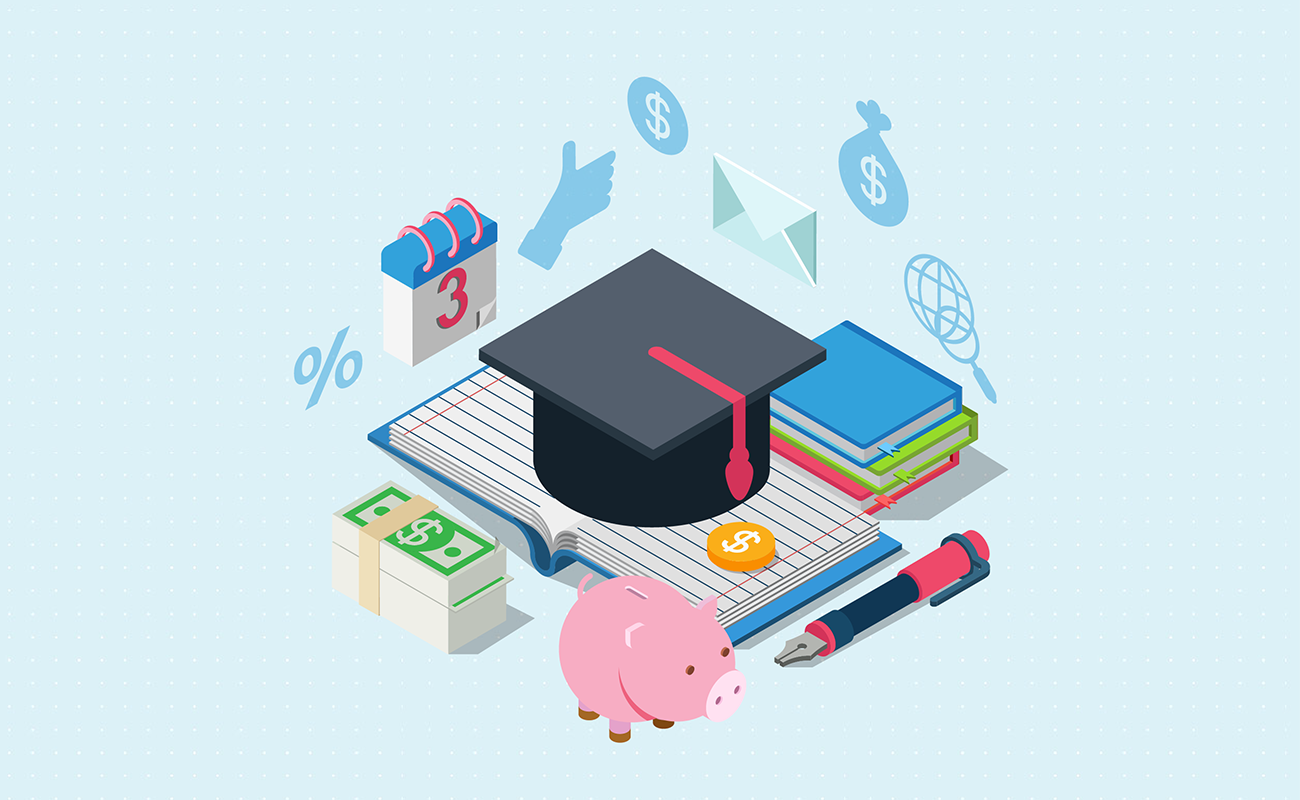Savings Goals
Net Worth
 Education Savings Calculator
Education Savings CalculatorThis calculator helps parents figure out how much they will need to set aside each month in order to fund their child's education. You can enter an estimated cost of college or use our default data from The College Board's Annual Survey of Colleges for the 2018-2019 school year. Projected college attendance costs include tuition and fees, room and board, transportation, books, and other expenses. All costs are enrollment-weighted & inflated based on your selected estimated rate of inflation. To be conservative this calculator does not presume further investment returns once the student is enrolled in college.
Authored by Jose Abuyuan on November 12, 2019

Recently living costs have grown faster than wages, making it hard for Americans to save up for major expenses. Saving for retirement and their child's education feels out of reach for many in the workforce as the costs of rent, healthcare, and education continue to skyrocket, leaving little wiggle room to plan ahead.
The rising costs of college tuition, coupled with the costs of student living, have made tertiary education a luxury to many people. Even those who could afford it still face the daunting prospects of debts in the wake of graduation, which can linger and affect their life choices. Without adequate preparation, many parents can expect the same story to play out for their children.
In the third quarter of 2018, student debts surpassed auto loans and credit cards, trailing only mortgages. At the end of September 2019 students owed over $1.638 trillion on student loans. Many find themselves in a nigh-inescapable debt trap if they are unable to land good jobs upon graduation.
Landing a job is no guarantee of an immediate reprieve; a study suggests that four-year degree holders in the U.S. today may expect to burdened by student loans nearly two decades after graduating, exceeding the Federal repayment timetable by nine years. The repayment terms are even longer for people with advanced degrees.
The burden of debt can have a profound effect on the new graduate’s life choices. Money spent repaying their loans can undercut their ability to afford investing in a home or buying a new vehicle. These delays can set back their ability to save and invest for the future, undercutting their ability to afford marriage, having chilren & securing their child’s education.

The cost of tuition is often the deciding factor in choosing a school or degree program.
The price of degree programs can vary immensely.
One degree may cost more in one college than another, while the quality of education may be similar. The type of degree also makes a significant difference in whether the price of tuition is worth it. Many liberal arts degrees, for instance, may not offer many job opportunities for graduates. Others, such as STEM and engineering degrees, can open the doors to lucrative positions in several sectors. Taking out loans may be more than justified for a degree program that leads to a well-paying career path. Those in technology should be forewarned that they will need to retain themselves throughout their careers as cutting-edge technology quickly becomes obsolete:
“many of the latest technical skills that are in high demand today become obsolete when technology progresses. Older workers must learn these new skills on the fly, while younger workers may have learned them in school. Skill obsolescence and increased competition from younger graduates work together to lower the earnings advantage for STEM degree-holders as they age.”
Parents and students are wise to seize any finacial aid options available to them. Relying entirely on scholarships and grants is unlikely cover everything, but they reduce overall tuition expense and leave graduates with less debt. For some families these vital financial assistance programs may be the only way to afford their school of choice.

Tuition is far from the only major expense that can compel learners to take on debt. Collegiate living expenses add up, impacting the student’s quality of life. The price of these expenses reflect general trends that students have little control over. Planning ahead can help students find cost-effective alternatives.
College textbooks are expensive & recently their prices have inflated 4 times faster than inflation across the broader economy. Students in the United States can expect to pay $153 on reference texts per course, which can add up to $1,200 to $1,500 annually.
This is an absurd situation preventing many from acquiring their course materials.
One of the main culprits behind this soaring prices is a semester access code for workbooks and texts. According to a 2018 USPIRG study, access codes are utilized in nearly four out of ten courses. They are common among general education courses required for all students. These codes eliminate the textbook aftermarket as they expire at the end of the semester, making it impossible for the book to be re-sold afterward.
While living near campus may save time and transportation costs, rents are typically higher closer to school.
The prevailing price of real estate, coupled with development trends, can further stack the cards against students. On-campus housing is often insufficient to meet the needs of the student body, prompting them to live elsewhere. The growth of luxury apartments around campuses is pushing lower-income students away as they are priced out of the housing market.
Housing prices are especially sensitive since its costs are tied to convenience.
Living closer to school can help take stress out of attendance, but it may also cause financial stress tied to high rents. Freshmen at university towns can expect annual room and board costs around $10,000. For some commuting might be more affordable, though those who drive may discover expensive parking or long commutes as faculty take the best parking.
Student loans & other sources of financial aid may be used to cover rental costs, while others work in the summers or take on multiple part-time jobs to afford their rooms.

As the stereotype of the impoverished student living day-to-day off ramen noodles and trail mix paid for by loans suggests, life in tertiary education is no spring picnic for the average Joe or Jane.
For many young people from middle-income backgrounds, college life represents their first taste of financial difficulty. One-time costs such as essential furnishings for a dormitory room can run into the hundreds. Everyday expenses in college can reach upwards of about $2,000 a year.
Stretching out the limited funds on hand often influences students’ purchasing decisions. Trying to live off what’s left after tuition and rent can be a challenge. Among the biggest casualties of these shoestring budgets is food security and quality. The Journal of Nutrition Education and Behavior reports that 58 percent of college students suffer from malnutrition. Those who are less financially secure often cannot afford varied and nutritious diets; relying on instant noodles and other junk food that is inexpensive but unhealthy.
People attending college may face steep financial hurdles to meet their day-to-day needs. Students with spare time may take on part-time jobs to generate supplemental income. For some employment is not a feasible option; they instead rely on support from their families or student loans.
Parents and incoming students need to assess the importance of stretching out the school budget. Once tuition and rents are taken care of, reducing everyday expenses is the next vital step to secure their financial standing.

Knowing where to spend money is one of the most important life lessons anyone can learn. For many young adults, college is one of the best times to learn it firsthand. Conscientious spending decisionscan go a long way to reduce the cost of school.

Students should prepare a budget that outlines all their important expenditures. This will not only help them keep better track of their money but also help them identify where they could reduce their costs.
Students can save by furnishing their dormitory rooms with garage and rummage sale finds, or cut costs further by bringing older furniture from home. A little research can reveal many cheaper, better alternatives for common college expenditures. Couponing, a skill associated with homemakers, can be a useful skill for the student on a tight budget.
Students have little in the way of control over their course materials determined by their professors.
Competitive new options are becoming more common across colleges and universities across the country. Both of the following options are worth exploring.
Many students rely on financial aid to meet their daily living expenses. The fear of incurring even more debts may cause them to tighten their belts, which is not always healthy.
Others, meanwhile, experience the opposite effect. Having leeway to use loans for personal expenses may lead some to make less than prudent decisions. Rather than reducing their debt load by paying back unneed funds, they increase their daily budgets. This can lead them to live more extravagant lifestyles, which in turn may tempt them to take on further debts.

Students should remember to be careful with their lines of credit and use them only to cover academic expenses. If they must use loans, they should restrict them to the necessities for comfortable living . Luxuries should be paid for through previous savings or through money earned from part-time jobs.

Parents should save early to ensure that their children can afford to get a degree at an institution of their choice without having to borrow. New parents can fund up to $15,000 each per year tax-free in a child's 529 savings plan. 529 contributions are not tax deductible, but growth in these accounts is tax-deferred. Withdrawals used to pay for education expenses are not subject to federal taxes. Investing for a newborn gives almost two decades to compound, helping parents hedge against risks tied to short term economic volatility. Some colleges also offer an option to prepay for tuition.
Most students will require financial assistance, but student debt need not become a long-term burden. Choosing a degree for an in-demand field & going to a local school with lower costs can help students keep their debt in check.
As students approach graduation, they should pick a loan repayment plan that fits their career. They can automate payments from their bank accounts to avoid late penalties. Eliminating the student debt ball and chain as early can give them a better chance at planning a brighter future for their own children.
Jose Abuyuan is a web content writer, fictionist, and digital artist hailing from Las Piñas City. He is a graduate of Communication and Media Studies at San Beda College Alabang, who took his internship in the weekly news magazine the Philippines Graphic. He has authored works professionally for over a decade.